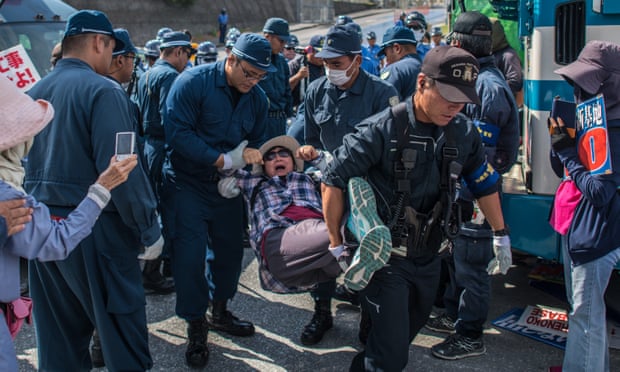Residents of Japanese island will vote on Sunday about controversial plan to move US military base
What is happening?
Voters on the Japanese island of Okinawa will vote this weekend in a referendum on the relocation of a US military base. They are expected to overwhelmingly reject it, but the government has indicated it will ignore local sentiment and press ahead.
Why a referendum?
The referendum was called by the prefecture’s anti-base governor, Denny Tamaki, in response to controversial plans to construct a US marine corps airbase on a remote part of the island.
Critics say the facility will destroy the area’s pristine marine environment and increase the risk of aircraft accidents. It is intended to replace the marines’ Futenma base, located in the middle of a densely populated city on the island. The facility has attracted frequent complaints about crime, noise and the threat of aircraft accidents in an area close to homes and schools.
Most Okinawans want Futenma to close and the replacement base to be built elsewhere in Japan. An Asahi newspaper poll conducted in the run-up to Sunday’s referendum showed that 68% of Okinawa voters said they intended to reject the relocation plan, with 21% in favour.
Why is the base so unpopular?
Opposition to the US military presence on Okinawa, the scene of one of the bloodiest battles of the Pacific war, surged after the 1995 abduction and rape and abduction of a 12-year-old girl by three US servicemen. The incident brought hundreds of thousands of Okinawans on to the streets.
A year later Tokyo and Washington agreed to reduce the US military footprint on Okinawa by closing Futenma and relocating its personnel and aircraft to Henoko, a fishing village on the island’s northeast coast. Washington also agreed to transfer about 8,000 troops and their dependants from Okinawa to Guam, Hawaii and other locations.
What’s wrong with the new site?
Opponents of the move say the new site will destroy the area’s delicate marine ecosystem, which includes one of the few remaining habitats for the dugong, and threaten the safety of 2,000 residents living closest to the site.
The move has stalled in the face of strong local opposition, to the irritation of US officials who insist the continued presence of marines on Okinawa is essential to Washington’s ability to respond to crises in potential regional flashpoints in the South and East China seas, and the emergence of a nuclear-armed North Korea.
Okinawa accounts for less than 1% of Japan’s total land area but hosts three-quarters of US bases and more than half of the 47,000 US military personnel stationed in the country.
What will happen after the vote?
Tamaki, who was elected in September 2018 vowing to oppose the base relocation, described the vote as a “precious” opportunity to communicate Okinawa’s opposition to the central government.
He is obliged to respect the result if it is backed by at least a quarter of the island’s 1.16 million eligible voters, but the ballot is not legally binding and is expected to be dismissed by the central government.
The chief cabinet secretary, Yoshihide Suga, declined to comment on the referendum but suggested that ongoing work on the Henoko base would continue regardless of the result. The government, he added, was trying to “ease the burden on the Okinawan people in a clearly recognisable way”.

